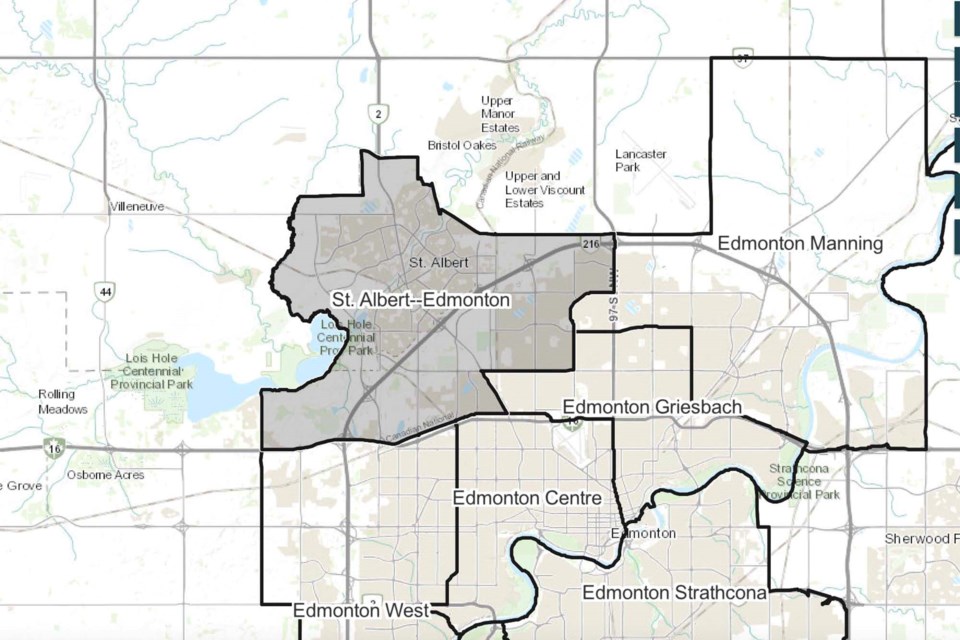The federal riding of St. Albert-Edmonton will morph into Sturgeon River if proposed boundary changes to the federal electoral district are adopted, but there has been some contention in the community about the proposed name.
“We have received a number of comments from the public that the name should really be St. Albert-Sturgeon River. We should have thought of it at the time, but now that [it has been] brought to our attention, that's likely going to be a change,” said Justice Bruce McDonald, chair of the federal electoral districts redistribution commission for Alberta.
The commission is welcoming public feedback on proposed boundary changes for federal electoral districts — including names — until Nov. 1 through emailed or written correspondence, or at one of several public hearings to be held across the province, including one in St. Albert on Sept. 13.
The proposed riding of Sturgeon River will stretch across into the territory which is now known as Sturgeon River-Parkland. It will include St. Albert, which had a population of 69,789 in 2021, according to the Alberta regional dashboard, and will have a total number of 114,803 in the electoral district.
Under the Constitution of Canada, the federal electoral districts are reviewed every 10 years after each decennial census. The process for the current redistribution process began in October 2021, according to the Elections Canada website.
McDonald said the commission — which consists of himself; Donald Barry, a professor emeritus of political science at the University of Calgary; and Donna Wilson, a member of the 2012 Federal Electoral Boundaries Commission for Alberta — was formally established by an order in council after it passed Nov. 1, 2021, but they couldn’t “earnestly” get to work until February 2022 when Elections Canada was provided with census data from Statistics Canada.
McDonald said the population in Alberta increased by about 800,000 people since the last decennial census in 2011. According to data from Statistics Canada, the population of Alberta in 2021 was calculated at 4,262,635. In 2011, the population of the province was 3,645,257.
“Under the formula that applies to Alberta and most other provinces, we were allocated three additional electoral districts, or ridings, to reflect that increase in population,” said McDonald.
McDonald said they were then tasked with building a proposal based on 37 electoral districts, an increase from 34.
Since most of the population growth was between Calgary, Edmonton, and the corridor that joins the cities, that is where the new ridings were added. These include Calgary McKnight, Airdrie-Chestermere, and Spruce Grove-Leduc.
“Those are the three new ones. Some of the existing ones have been reworked quite a bit,” he said.
Under the act, McDonald said, each province has an electoral quota which is obtained by dividing the census populations with the 37 proposed electoral districts. The electoral quota for Alberta was calculated to be 115,206, with the proposed Sturgeon River being a small fraction below the 115,000.
“Ideally, every electoral district in Alberta would have that exact number. Of course, that's an impossibility in the real world … we try our best to make sure every vote has as much weight as the next,” said McDonald.
The population of each proposed boundary varies, but none has a population more than five per cent above or below the electoral quota, said McDonald.
A cartographer assists the commission in selecting the boundaries.
“Whenever we want to draw a line for a proposed boundary, we say where we want the line, and [the cartographer] can work her magic, and then according to the census data [she] can advise how many people are in that proposed writing,” he said.
McDonald said the proposed districts and the way they are divided is mandated by section 15 of the Electoral Boundaries Readjustment Act. Population is one main factor in the division, but the commission must also consider communities of interest, communities of identity, historical patterns, and sparse population, as seen in the northern ridings.
The driving factor in the proposed boundary changes for St. Albert was the historical factor.
“It's one of the oldest settlements in Alberta, and by putting it in Sturgeon River, it is in with some of the other historical Francophone community,” said McDonald who added the commission has received supportive feedback from the public about the change, “and as one individual pointed out, St. Albert's growth is projected to be towards more the north and the east.”
McDonald said the commission decided to eliminated hybrid ridings such as the St. Albert-Edmonton riding as they did not want a “community of interest in the community identity of a big city.”
“[What] we, as a commission decided was that both Calgary and Edmonton — since they are the two major cities — all their electoral districts would be within the city limits,” he said.
McDonald said the commission is quite proud of that the two major cities in the province have almost the exact same percentage of electoral districts.
“There's no political axe to grind. Ours is an exercise driven to a large extent by the numbers,” he said.
The commission is set to file a report in Parliament on the proposed changes based on feedback by Dec. 15. It is anticipated the new federal electoral districts will be in effect for the general election held after April 1, 2024, at the earliest, according to the redistribution website.
A public hearing about the proposed boundary changes will take place at St. Albert Inn & Suites at 7 p.m. on Sept. 13. The commission will also hold two virtual hearings, at 1 p.m. and 7 p.m. on Oct. 14. information can be found at: https://redecoupage-redistribution-2022.ca/
Emails about the changes can be sent to [email protected] or mailed to their office at: P.O. Box 45062 Calgary, AB, T2G 4X3




